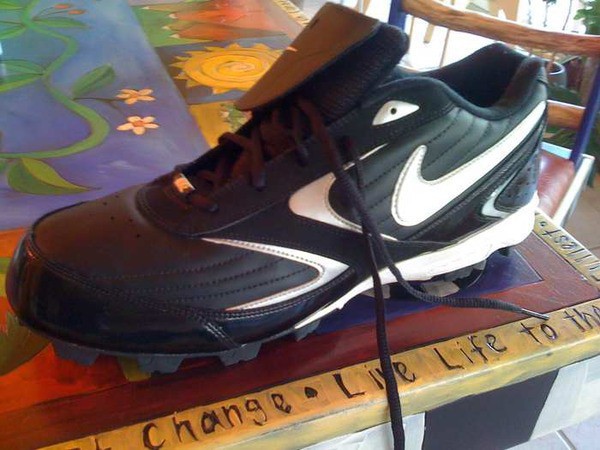2009
- Riders are tested very fequently.
- Riders do not know when they will be tested.
- The testing is inconvenient and a challenge for the athlete to accommodate.
Bartender Bricker.
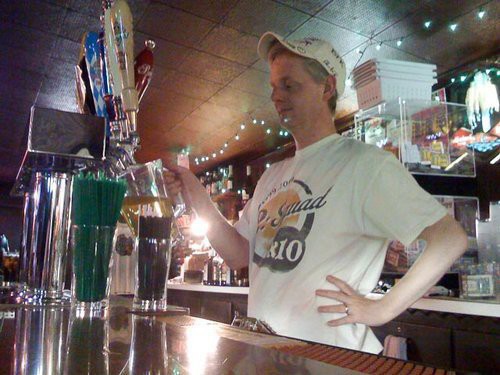
Tulips.

My first deep dish pizza on the Big Green Egg.
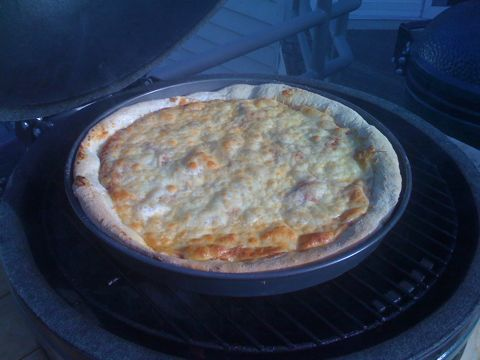
Mazie making pizza!
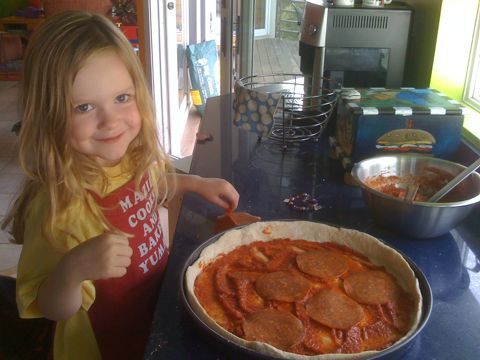
Dozen cars in line at the drive-thru at Caribou Coffee this morning. GET OUT OF YOUR CAR AND SAVE 15 MINUTES!

Entrepreneurship Class at Carlson
About a month ago I spoke at an entrepreneurship class at the Carlson School of Management. Nice group with a lot of good questions.

Chase
I just submitted my very first photo to JPG Magazine in their “Shoot Your Pet!” theme. Crossing my fingers that they will publish it.
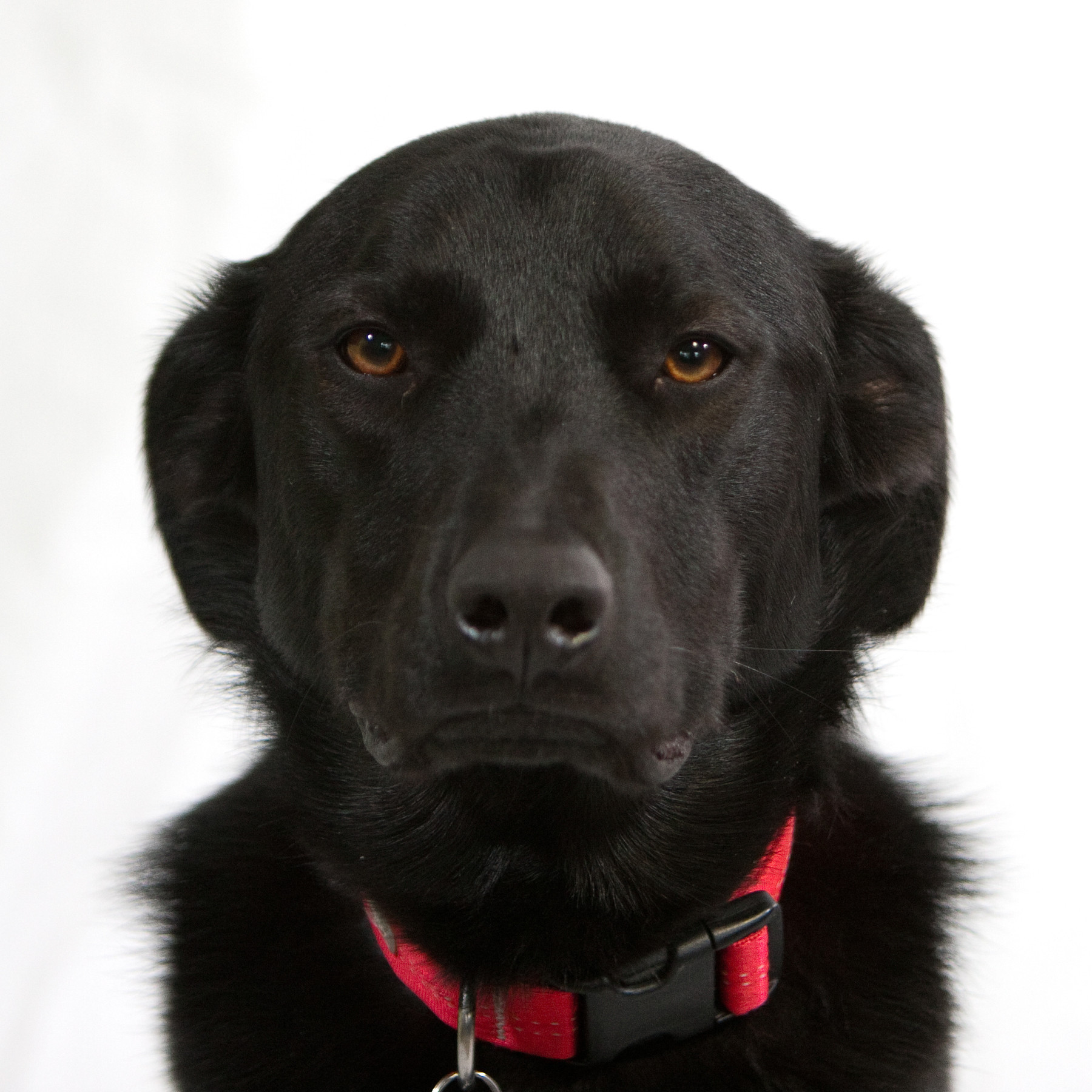
Jim Bernard and Mike Black at Dusty’s after B-Squad game.

Why do Cyclists Tweet?
I’ve gotten a lot of positive feedback from the release of VeloTweets. Thank you everyone for that, and please help spread the word about the site. These projects are about creating something that people love. There is no business behind it. The more people that like it, the more likely we are to make further improvements to it.
There is a secondary question that people have asked about extending something like VeloTweets into other sports. I think it is possible that could work, but I think that cycling has some unique characteristics that make it particularly well suited for Twitter. Through Twitter the peloton can send two really clear messages.
Doping
Anyone who even casually watches cycling knows that doping is a huge problem. I’ve written before about doping in cycling, and sadly the sport continues to be plagued with this. Cycling is an endurance sport that is won by fractions of percentages. The slightest advantage, no matter how small, can be the difference between winning and losing. Sadly, some cyclists turn to illegal measures to get that last 0.1% performance edge.
Lance Armstrong does something very interesting in his Twitter stream. Most times when he is randomly tested, he sends a message about it.
Sorry, I meant #27. I'm losing count. And I'm tired.
— Lance Armstrong (@lancearmstrong) May 13, 2009
Surpise doping control. #26 for those counting.
— Lance Armstrong (@lancearmstrong) May 13, 2009
Good morning from Jesolo (outside of Venice). UCI blood control this am prior to the start of the Giro.
— Lance Armstrong (@lancearmstrong) May 7, 2009
UCI anti-doping control. #25. Been awhile. Thought they forgot about me.
— Lance Armstrong (@lancearmstrong) April 30, 2009
The themes here are pretty simple and powerful.
In the past riders have sent messages about the negative effects of the anti-doping controls on their performance, most notably by stopping in the middle of a race, or waiting several minutes to start at the beginning. Sleep is critical for endurance athletes, and having that disturbed with hours of testing in the middle of a Grand Tour is understandably frustrating.
Riding Constantly
The other message that you see when you look at the messages from riders in the professional peloton seems obvious, but it’s worth noting.
They ride their bikes all the time!
The pictures that cyclists post, the messages they send clearly show how much effort and time is put in on the bike. This is the secondary message to the doping message, and says strongly “I have earned this!”.
Messaging via Social Media
I think these two messages are great for cycling and I think that the message comes through directly and indirectly. As such, I would not be surprised to hear of riders really encouraging other riders to take up Twitter. It is an amazingly simple and easy way for them to directly reach the fans and rebuild the image of the sport.
This is a great social media marketing plan and it will be really interesting to see how well it works.
Having said all this, I’m sure there are many reasons why cyclists have found Twitter useful. For example, being a professional cyclists is a life on the road and Twitter is very mobile friendly. Living out of a suitcase on a team bus works with Twitter.
The Typographic Desk Reference
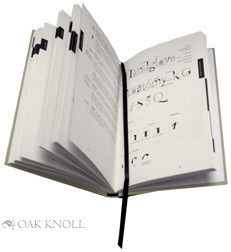
A couple of weeks ago I was reading one of my favorite typography websites, I Love Typography, and saw their article about Theodore Rosendorf’s The Typographic Desk Reference. I was intrigued right away.
In recent years I’ve become much more interested in typography. In fact, on my own website I always push for layouts that focus on typography over graphics. I’ve been practically giddy recently when discussing the potential of @font-face in web design with Garrick Van Buren (stay tuned to his Kernest project by the way). I’m not a student of type, as I’m not a student of art. However, that doesn’t keep me from admiring beautiful type and appreciating the subtle elegance of a great type.
The Typographic Desk Reference looked interesting to me as a way to understand the terms and anatomy of type and it delivers wonderfully. This is a great book if you want to cut to the chase and get familiar with terminology and style quickly. Rosendorf has put together a very useful book. Here is an example of the depth offered in this book. You probably assume you know what a serif font is, well…
serif A small stroke at the end of an arm, stem, or tail of a character. Serifs are either reflexive or transitive. Reflexive strokes are either unilateral or bilateral. Additionally, reflexive strokes can be abrupt, or adnate. Typically unilateral, transitive serifs - as with italics - flow smoothly out of the main stroke.
Additionally, I have to comment that this book was obviously put together with amazing care and thought. The placement of information, the structure of it, the binding, the paper and of course the type were chosen with care. Flipping through the pages reminded me of the obsessive focus that Tufte must put into his books. The effort is recognized and appreciated.
If you like type, I recommend this book. While your at it, how about ordering it straight from the publisher Oak Knoll, rather than Amazon.
Introducing VeloTweets - The Pulse of the Peloton

A couple of months ago I started to notice that there were a lot of professional cyclists that were getting on Twitter. Lance Armstrong (@lancearmstrong) was really active, as were a couple of dozen other riders. I was interested in what they had to say, but I also didn’t want to have thirty or more new feeds in my Twitter stream. So, I decided to just subscribe to the RSS feeds of these riders and put them in Google Reader.
As I read these feeds I started to see some really cool trends. When the early spring classics were happening you could get a sense from other riders on how they thought the races went down. You could see a first person view into what was going on in the peloton.
It hit me that there was something interesting here and that if these Twitter streams were put together with the right display as well as some additional metadata it could be a really interesting way to experience the sport from a never before seen perspective. The idea of VeloTweets was born!
The Team
I liked the idea, but I knew I wouldn’t be able to do this on my own. Luke Francl and I had chatted about cycling and I knew he was into it. Luke approached Norm Orstad about the project and Norm was into it. I asked my friend Chris Hatch, who is a rabid cycling fan, if he would help with some editorial work. Everyone was in, and we had a team with no budget and limited time. The best way to hit a side project. :-)
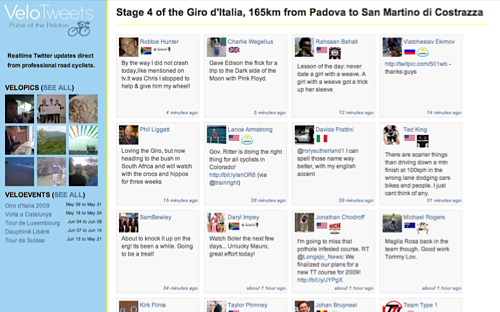
Luke put together all the code, Norm did the designs and Chris did the research while I played sweeper behind everyone and helping out on the edges in all the areas I could.
If you curious how the application was built, you should read Luke’s Rail Spikes post about VeloTweets.
Why is this cool?
The utility around VeloTweets comes from aggregating the Twitter streams together and then applying a thin layer of metadata on top of that. Team affiliations and nationality are the ones that we added in the first release. We really wanted to add jersey counts to show how many jerseys a rider held by each type (yellow, green, polka dot, white) but we couldn’t find a free source for that data.
The point was to level the playing field and provide the insight that someone who knew the sport well would have to those who did have that background.
After our first of 2 days getting together to build the site I was struggling because I felt it looked too much like Twitter. A stream of status updates, not really adding much value. As we discussed this we had a breakthrough that helped a lot. Norm suggested the analogy of a baseball card and we quickly came up with the idea of having a grid where each rider is only shown once, with their most recent message.

This was a winner right away and solved a bunch of problems. Now the group was equalized. If you were really active or not, you would only show up once in the grid. The grid gave us a dynamic layout that we could use in any instance. For example, maybe we just want to see the information for Team Astana.

This view gives the reader the ability to quickly scan the breadth of the group, without getting stuck in the depth of any one rider.
We also started to dive into the information in the messages. We tackled pictures sent with the messages, specifically TwitPics and aggregate those into VeloPics. Now we can do something that you can’t do with any other client or feed mashup and show the aggregated set of pictures from the group (or team) in a grid to browse. There are bound to be some awesome shots of bikes and other riders in there and this aggregation lets you see them all.
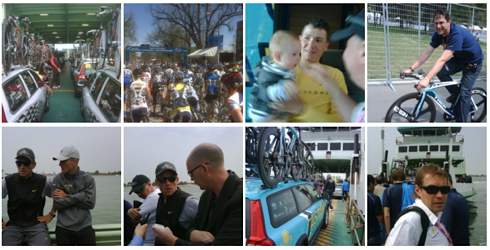
We also put a “Message of the Day” on the site so that you instantly know what is going on that day. If there is a grand tour going on, it will highlight the stage for the day. And, most of the time (no guarantees) it is even updated to reflect the outcome of the race. This is a great grounding point to understand the context of the messages from the group.
We also have integrated a race calendar so we can show when races are. We’d love to add some other data sources over time, we’ll see. All part of being the Pulse of the Peloton.
Thanks!
My huge, huge thanks to Luke, Norm and Chris for their help getting this launched. It was enormously fun to work with these guys and to see what we could get done with the limited time available.
If you want to stay tuned on updates to VeloTweets follow @VeloTweets on Twitter!
Now, back to the Giro…
Starting to work up three racks of ribs for Mothers Day dinner on Big Green Egg.
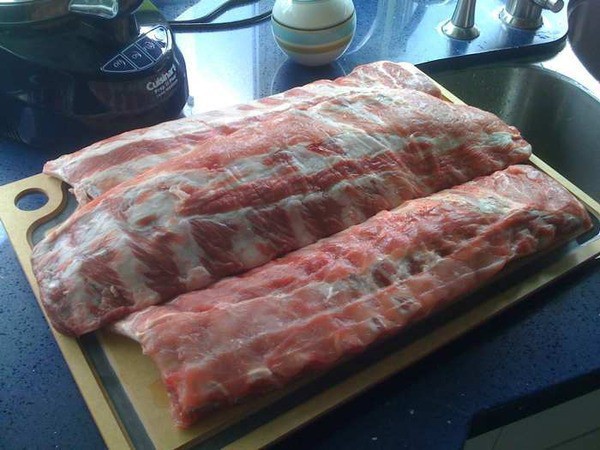
Checking in on the ribs in the Big Green Egg. Warning: this picture may cause hunger. 🙂

Ribs are up to temp! Capping the Big Green Egg and will let them sit on it until dinner!
Ribs anyone? Big Green Egg FTW!
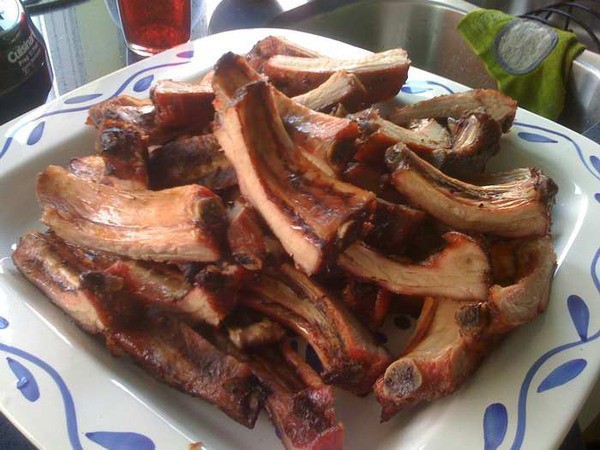
I’m quickly approaching an EPIC FAIL for Mother’s Day. Ugh.
Finally took the time to get all my home directory dotfiles into a Git repo. Feel happy and tidy.
Having a blast and learning a lot at the Grillmaster Pizza class. Bonus, Anna Klombies’s husband Lindsay is here rocking the thin crust pizza.
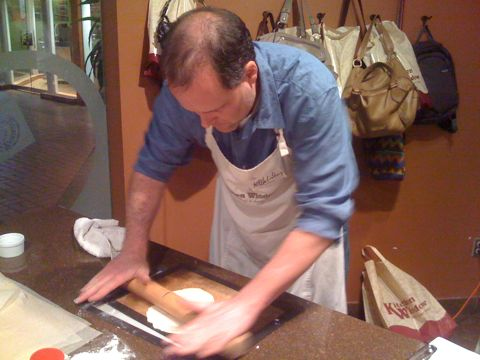
I really dig iStockphoto. It is like a project accelerator.
Took less than 24 hours for the cat to puke on the BRAND NEW carpet. I don’t think the cat realizes how tenuous her position here is. 😕
Just made my first Thawte Web of Trust assertion!
I’ll be a pro at the next B-Squad game with these awesome shoes.
